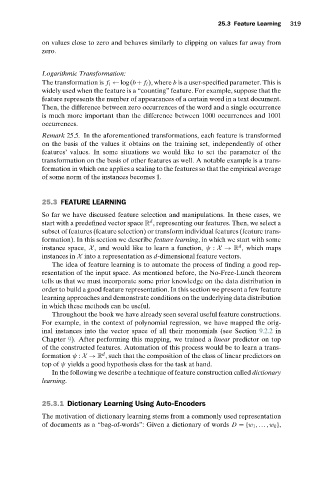Page 337 - Understanding Machine Learning
P. 337
25.3 Feature Learning 319
on values close to zero and behaves similarly to clipping on values far away from
zero.
Logarithmic Transformation:
The transformation is f i ← log(b+ f i ), where b is a user-specified parameter. This is
widely used when the feature is a “counting” feature. For example, suppose that the
feature represents the number of appearances of a certain word in a text document.
Then, the difference between zero occurrences of the word and a single occurrence
is much more important than the difference between 1000 occurrences and 1001
occurrences.
Remark 25.5. In the aforementioned transformations, each feature is transformed
on the basis of the values it obtains on the training set, independently of other
features’ values. In some situations we would like to set the parameter of the
transformation on the basis of other features as well. A notable example is a trans-
formation in which one applies a scaling to the features so that the empirical average
of some norm of the instances becomes 1.
25.3 FEATURE LEARNING
So far we have discussed feature selection and manipulations. In these cases, we
d
start with a predefined vector space R , representing our features. Then, we select a
subset of features (feature selection) or transform individual features (feature trans-
formation). In this section we describe feature learning, in which we start with some
d
instance space, X, and would like to learn a function, ψ : X → R , which maps
instances in X into a representation as d-dimensional feature vectors.
The idea of feature learning is to automate the process of finding a good rep-
resentation of the input space. As mentioned before, the No-Free-Lunch theorem
tells us that we must incorporate some prior knowledge on the data distribution in
order to build a good feature representation. In this section we present a few feature
learning approaches and demonstrate conditions on the underlying data distribution
in which these methods can be useful.
Throughout the book we have already seen several useful feature constructions.
For example, in the context of polynomial regression, we have mapped the orig-
inal instances into the vector space of all their monomials (see Section 9.2.2 in
Chapter 9). After performing this mapping, we trained a linear predictor on top
of the constructed features. Automation of this process would be to learn a trans-
d
formation ψ : X → R , such that the composition of the class of linear predictors on
top of ψ yields a good hypothesis class for the task at hand.
In the following we describe a technique of feature construction called dictionary
learning.
25.3.1 Dictionary Learning Using Auto-Encoders
The motivation of dictionary learning stems from a commonly used representation
of documents as a “bag-of-words”: Given a dictionary of words D ={w 1 ,...,w k },

